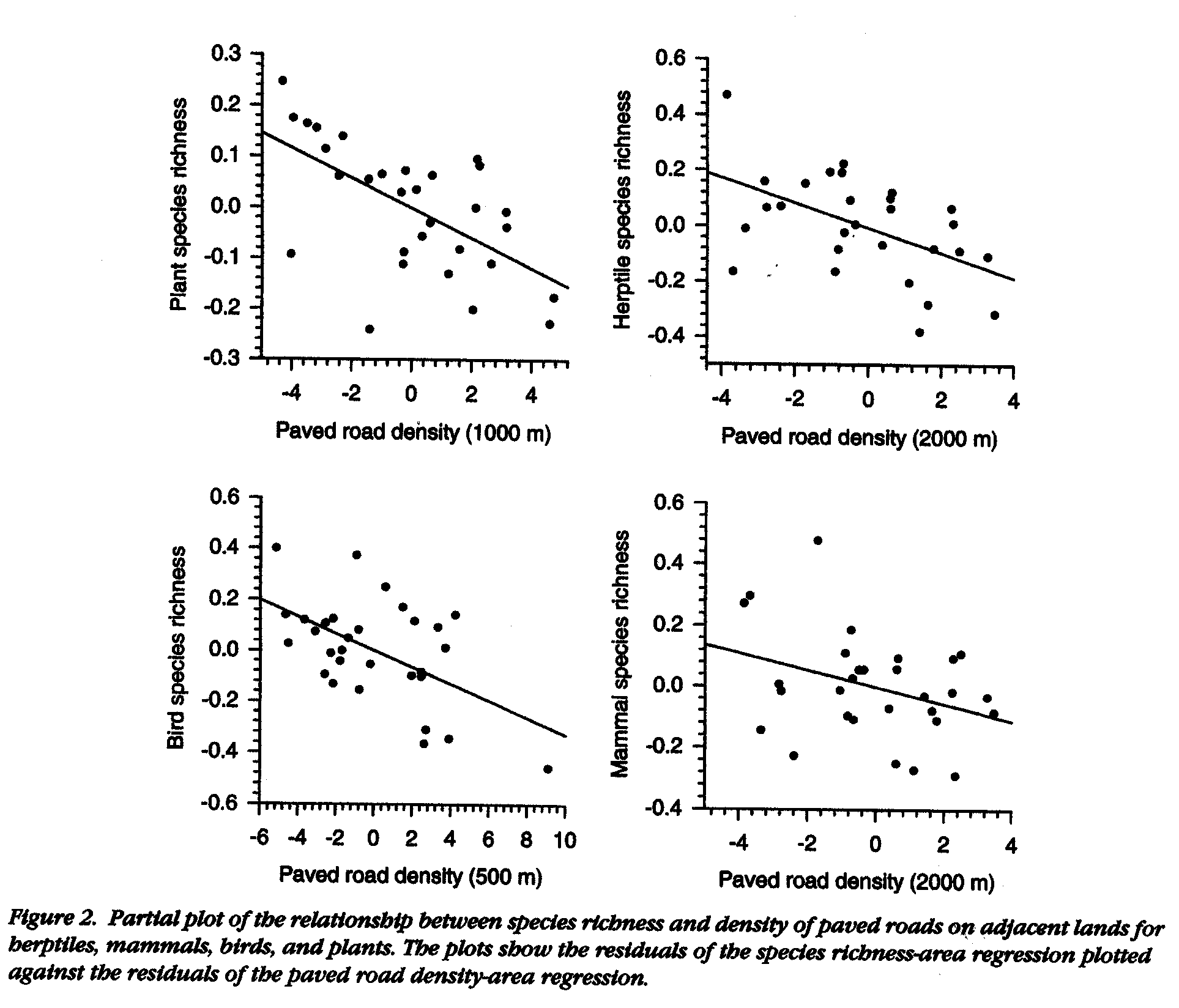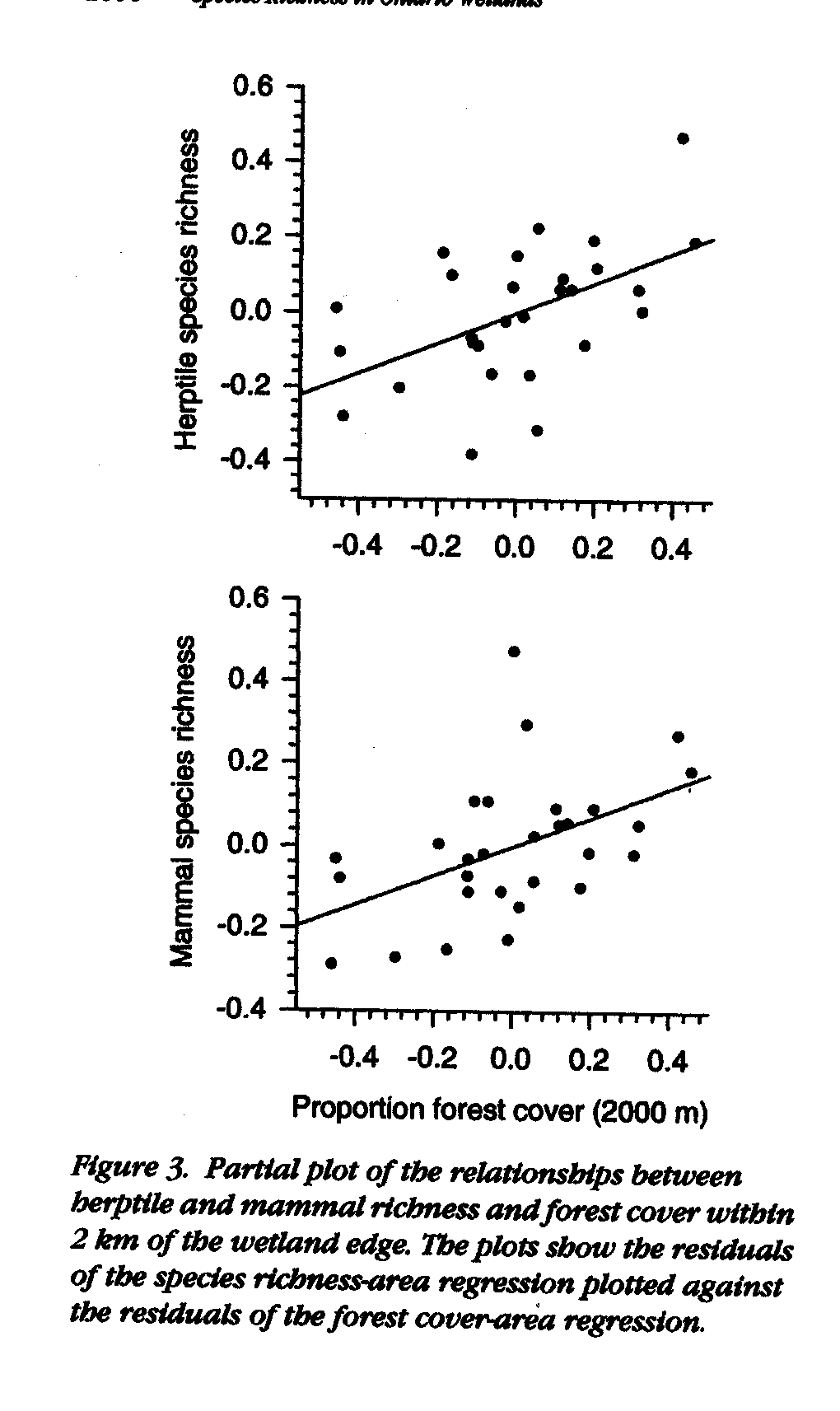Using Amphibians as Indicators of Wetland Integrity
Amphibians are a natural wetland species and are also sensitive to disturbances, especially in the larvae form (Hecnar and M'Closkey 1996a). In addition "the unique life histories of
amphibians and reptiles make their role in food webs diverse and important" (Bishop and Gendron 1998). Not
only are amphibians closely tied to invertebrate and macroinvertebrate populations through the food web, they make
up a large portion of wetland biomass (Bishop and Gendron 1998). Amphibians have great potential to act as ecological
indicators in wetlands (Hecnar and M'Closkey 1996a). In past experiments, these animals have been proven to be
an excellent aid to assess wetland health (Adamus et al. 2001).
In a study of amphibian colonization and populations in created pools that represents replacement wetlands, it
was found that the distance to the nearest woodland was an important factor in the diversity of amphibian species
(Laan and Verboom 1990). It is suggested that the presence of steep inclines or roads near wetlands may have a
negative effect on amphibian species diversity, most likely because these banks and roads act as a barrier between
forest and wetland (Laan and Verboom 1990, Findlay and Houlahan 1997). In a study of anthropogenic effects on species
richness, it was found that increasing road density within 2 kilometers of a wetland is significantly correlated
to a decline in species richness. A 2 meter per hectare increase in road density results in the decrease of amphibian
species by 19 percent, bird species by 14 percent, and mammal species by 12 percent (Findlay and Houlahan 1997).
In addition, it was found that the proportion of forest cover available to amphibians was significantly correlated
to the species richness (p=0.001 Hecnar and M'Closkey 1996b, Findlay and Houlahan 1997).

Pechmann et al. (2001) conducted a long-term study with the goal of determining the effectiveness of mitigation
to compensate for wetland loss. Amphibians were used as ecological indicators, and colonization, population, and
diversity were measured in created pools both before and after the natural wetland was filled (Pechmann et al.
2001). It was found that the community structure of amphibians, including frogs and salamanders, was significantly
different between the reference and created wetlands (p<0.0001, Pechmann et al. 2001). Salamanders, a biologically
sensitive species and indicator of good health, were found in high numbers (4-5 different species) in the reference
wetland. The salamanders were expected to migrate and establish themselves in the near-by mitigation wetlands;
however, it was found that only a few individuals made it to the mitigation wetland, and left soon after arriving
(Pechmann et al. 2001). The salamanders did not return until 7 years later, in 1990, and in low numbers (5, 139,
65) and species diversity (three species) (Pechmann et al. 2001). This indicates that even after 7 or 8 years,
mitigation wetlands do not support sensitive species, like the salamander.
The age of wetlands has an effect on the population numbers. In the experiment conducted by Laan and Verboom (1990)
it was found that all established pools supported amphibian populations, whereas 90% of the newly created pools
supported amphibians. The number of individual amphibians sampled in established wetlands was also higher in seven
out of eight of the species sampled (Laan and Verboom 1990). High species diversity in natural, established wetlands
suggests that amphibians have a preference for natural wetlands over newly created wetlands.
In a different study concerning regional amphibian loss, it was found that heavy application of pesticides and
herbicides on agricultural fields in combination with the loss of wetlands and riparian zones has caused a loss
in amphibian species diversity (Hecnar and M'Closkey 1996b). A trend in amphibian species richness indicates that
diversity is decreasing (not significant, Hecnar and M'Closkey 1996b). On the other hand, the amphibian species
richness between the three sites was significantly different, although reasons explaining the differences were
never given (p<0.0001 Hecnar and M'Closkey 1996b). It is possible that Stratford, the site that had the highest
species richness, was located near a forest, while Essex, the site with the lowest species richness, was in a very
degraded area.

The reduced opportunities for colonization of suitable ecosystems by amphibians is causing large scale amphibian
loss and increased extinction rates of metapopulations (Hecnar and M'Closkey 1996b). A study conducted by the Declining
Amphibian Populations Task Force (DAPTF) supports the conclusions that habitat destruction, fragmentation, and
contamination is causing serious declines in amphibian populations (Vial and Saylor 1993). The DAPTF also concluded
that the introduction of non-native predatory fish in amphibian habitats is having a negative effect on populations
(Vial and Saylor 1993).